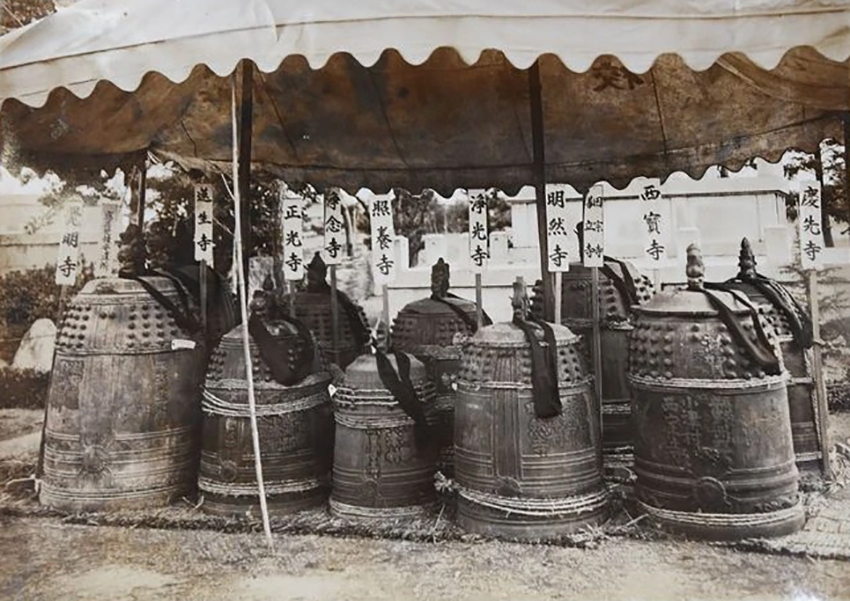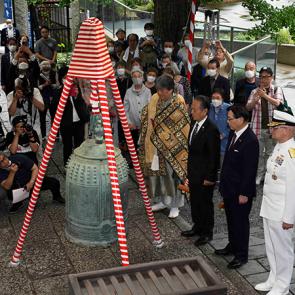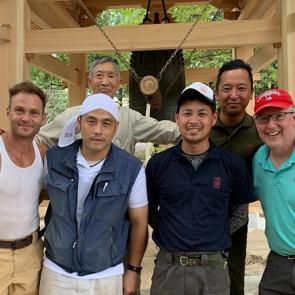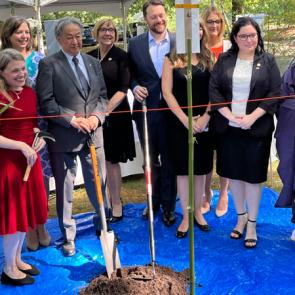Japan
Explore the deep and eddying resonance of bells in the
Land of the Rising Sun.
“The sound of the Gion Shōja bells echoes the impermanence of all things.”
The Tale of the Heike
Image: A Buddhist monk tolls a bell before prayer at a monastery in Kamakura, Japan.
Hello, bonshō!
Bonshō, sometimes called tsurigane or ōgane, are bells found on the immaculately manicured grounds of Buddhist temples throughout Japan. Cast in bronze, bonshō hang solemnly in roofed but wall-less structures known as shōrō. They are hung mouth-down and remain motionless, with sloping shoulders and a flat base said to emulate the seated posture of Buddha.
Hear a bonshō in action.
Video: Monks at the Chion-in temple in Kyoto, Japan, ring the bonshō on New Year’s Eve.
Peace Bells
Japanese bells have become internationally-recognized symbols of peace and diplomacy. With the establishment of the World Peace Bell Association, new bonshō are cast and installed around the globe to strengthen understanding and collaboration between peoples of different cultures. Bells of peace? Our world could certainly use more of both.
Image: United Nations Secretary-General António Guterres rings the Peace Bell north of the Secretariat Building at the UN Headquarters in New York on September 21, 2018, to mark the International Day for Peace.
Imperial Silence
The plundering of bells during World War II
As war ravaged the Pacific, an ordinance to collect metals was decreed throughout Japan. To feed its war machine and keep its armies outfitted, Japan needed vast quantities of industrial materials – and like plucking fruit from a tree, they turned to peaceable, defenseless bell towers. An estimated 70,000 bells (approximately 90% of the bonshō then in existence) were destroyed and smelted into armament.

Image: Bells surrendered to the armed forces of Imperial Japan are collected at a school in Shiga Prefecture and await transfer for smelting, 1942. Courtesy: Kakumeiji Temple, Moriyama.
Great Bells
Japan is home to some of the largest, oldest, and most resonant bells in the world.
Chion-in
Chion-in
City: Kyoto
Installation: Temple
Practice: Jōdo-shū
Cast: 1636
Weight: 35 tons
Diameter: 9 ft.
Hōkōji
Hōkōji
City: Kyoto
Installation: Temple
Practice: Tendai
Cast: 1614
Weight: 30 tons
Diameter: 9 ft.
Tōdai-ji
Tōdai-ji
City: Nara
Installation: Temple
Practice: Kegon
Cast: 1239
Weight: 35 tons
Diameter: 8.9 ft.
Myōshin-ji
Myōshin-ji
City: Kyoto
Installation: Temple
Practice: Rinzai Zen
Cast: 698
Diameter: 34 in.


















